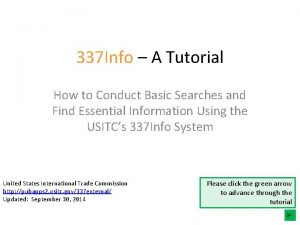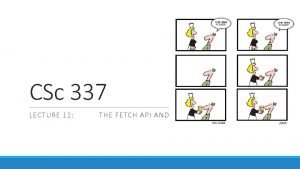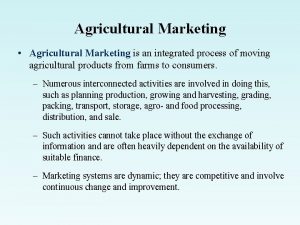ECON 337 Agricultural Marketing Chad Hart Associate Professor


























- Slides: 26

ECON 337: Agricultural Marketing Chad Hart Associate Professor chart@iastate. edu 515 -294 -9911

Why Should you have a Marketing Plan? • Detached from the decision • Proper perspective • Introduces discipline and consistency • Check your logic • What if…

Fear, Greed, and Ego Fear of making a bad decision -- Watching prices slip away as you wait -- Watching prices rise after you’ve sold Greed of expecting even higher prices -- Not taking advantage of good price opportunities Ego of wanting to claim you caught the market high -- “Lake Wobegon” marketing

ar ed Fe G re Ego

What is a Marketing Plan? A marketing plan is an outline of price, date, and quantity objectives used to generate a reasonable return given the existing market conditions.

8 -Step Marketing Plan 1. Describe your current operation 2. Specify goals 3. Know your costs of production and break-even 4. Utilize sound market information 5. Set target prices 6. Evaluate pricing alternatives and actions − Cash, futures/options, forward contract 7. Execute when target prices are hit 8. Review and evaluate results

1. Describe your current operation… • • • Annual marketing's: number, weight, timing of sales Input purchases: feeders, feed needs, crop inputs Cost of production: cash and total costs Alternative market outlets: distance, transportation costs Marketing philosophy: sell on tight schedule, shop for best price, standing order • Attitude toward price risk and knowledge of risk management tools • Where are you going?

2. Specify goals… • • Manage risk and protect profit potential Goals should be achievable and measurable If and when consistently met – revise upward Examples: − Selling price 5% higher than the auction or plant average − Sell in top 1/3 of price range − Cover total costs plus growth requirements − Cover cash requirements

3. Know your costs of production and break-even… • Production history and expectations • Incorporate input quantities and prices • Project costs on per unit sold − Variable $/unit − Total $/unit • Budgeting tools available − http: //www. extension. iastate. edu/agdm/livestock/ html/b 1 -21. html

3. Know your costs of production and break-even… • Project a break-even level − Price to cover variable costs − Price to cover fixed costs − Price to cover profit and growth • Sensitivity analysis for key variables • Back calculate from revenue to what you can afford to pay for feeder animals

4. Utilize sound market information… • Factors that impact price − Supply − Demand and supply balance • Systematic price variations − Trends − Cyclical movements (cattle cycle, hog cycle, etc. ) − Seasonal price patterns

4. Utilize sound market information… • Market information and projections − USDA reports (weekly, monthly, annual) − Extension forecast/outlook reports − Commodity organizations − Newsletters − Private marketing firms

5. Set target prices… • Set target prices based on actual or accurately estimated production costs • Know what the market is paying (or expected to pay) • The level and timing of target prices based on: − Market outlook information − Cost of production figures − Cash flow needs • Advantageous to set several target prices − Allows for changing market trends

6. Evaluate pricing alternatives and actions…

6. Evaluate pricing alternatives and actions… Method Advantages Disadvantages Cash sales • Easy to transact • Immediate payment • No set quantity • Minimize risk • No price protection • Less flexible Forward contract • • • Must deliver in full • Opportunity loss if prices rise Futures contract • Easy to enter/exit • Minimize risk • Often better prices than forward contracts • • Options contract • • • Premium cost • Set quantities • Commission cost Easy to understand Flexible quantity Locked-in price Minimize risk Price protection Minimize risk Benefit if prices rise Easy to enter/exit Opportunity loss if prices rise Commission cost Performance bond calls Set quantities

7. Execute when target prices are hit… Price Target 1 2 3 4 5 6 7 Futures Price 50. 72 76. 24 79. 19 82. 14 86. 19 90. 25 94. 30

8. Review and evaluate results… • Check performance relative to marketing goals • Biggest reason for failure to repeatedly use marketing plans is that performance is compared to what might have been − Typically the highest price alternative − Probably an unrealistic goal • No one strategy is best all the time • Are conditions changing?







What Makes a Marketing Plan Work? • Know your market positions − Track all positions – where do you stand on % sold and average price? • Make the plan manageable − Don’t expect to achieve your highest targets − Focus on only tools you feel comfortable using − Set price targets that are realistic − Use multiple sources of analysis

A Little Marketing Philosophy • Bad outcomes still happen… • Never compare to the market high… • Remember it’s your plan for your operation…

Class web site: http: //www 2. econ. iastate. edu/faculty/hart/ Classes/econ 337/Spring 2018/index. htm
 Promotion from assistant to associate professor
Promotion from assistant to associate professor Stars dogs plowhorses and puzzles
Stars dogs plowhorses and puzzles 337 form example
337 form example Faa form 337
Faa form 337 337 form example
337 form example 337info
337info Esneyebilen bir tabaka üzerine ince bir telin
Esneyebilen bir tabaka üzerine ince bir telin Csc 337
Csc 337 Csc 337
Csc 337 Agricultural marketing communications
Agricultural marketing communications Agricultural marketing circle
Agricultural marketing circle Scope of agricultural marketing
Scope of agricultural marketing Marketing mix of agricultural products
Marketing mix of agricultural products Chad b swim helping verbs
Chad b swim helping verbs Gga chad
Gga chad Rytmekontrol
Rytmekontrol Chad ulven
Chad ulven Chad sperry
Chad sperry Sigmachad
Sigmachad Chad topaz
Chad topaz Hotwash ground rules
Hotwash ground rules Chad posner
Chad posner Uiaddi
Uiaddi Chad lessard
Chad lessard Chad blight
Chad blight Chad rikansrud
Chad rikansrud Chad braley
Chad braley


















































